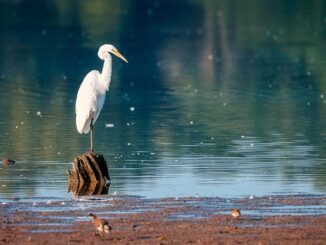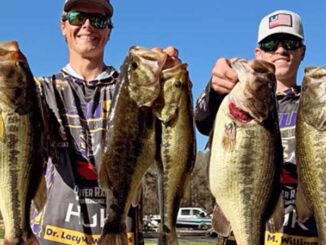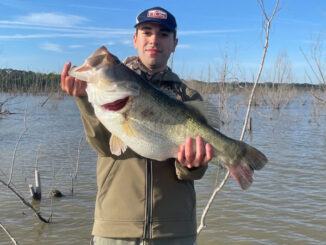
What is 29 inches long, weighs 10 pounds and is just “warming up” for the winter? It, and many more like it, are Caney Lake largemouth bass.
The new year and lunker bass time will be here on Caney Lake as they run up the score on the digital scales past 11, 12, 13 and maybe even higher. But first, there’s more “game” to play this year.
While most of the attention is on these monsters of the Jackson Parish deep in cold weather, Heath Kennedy who lives in nearby Chatham, has a secret for you.
You can catch big bass on Caney Lake all year long, including October and November.
You just have to vary your approach. Kennedy should know. He practices what he preaches. This fall he already caught one of those bass that weighed 10.0 pounds and was just a fraction below 29 inches long, “half as long as I am tall,” he said. And it was the longest bass he ever caught. It “only” weighed 10 pounds because it hadn’t had its fall feed-up yet.
Feeding up
They keep getting bigger this month as they start rounding up schools of shad. Anglers will start catching double-digit bass regularly this month, although they’ll get bigger as they near the spawning months.
“Yes sir, you can catch fish all year long at Caney and this month is a good month to try,” said Kennedy, a well-known big bass catcher on the lake. “The fish have been in the grass for the most part, chasing the bigger shad and beginning to feed up for winter. As the water starts getting cooler, which it is now, they start to move out to deeper water and set out on good feeding spots. That’s when they really feed. Frankly, there’s no way to tell where they will be based on the weather for the day or the date. It’s all about water temperature.
“If the water gets consistently below 60 degrees, a lot more of them start moving,” he said. “Until then, you catch catch them in that grass.”
While the bait — and the bass — are still in or around the grass, Kennedy said there are two ways to catch them. First, by punching plastics and jigs through the grass with a heavy weight. Second, by fishing the edges of the grass with swim baits and jigs.
“The good news is that the grass holds bait and stays warm a little longer than the open shallow water,” he said. “And we have twice as much grass now as we have had. So that’s a big plus.”
Kennedy’s go-to baits
In October, the fish can make a run up to the back of the creeks if the shad go there. But right now on Caney, the grass is the key. Sometime between the end of November and the end of December, the fish will mostly transition to the deeper holes, but some stay in the grass almost all year long, he said. You just have to put in a little time and when they do go back offshore, just look for a hump or change in depth where they can stage. It doesn’t have to be a huge difference, just some sort of change where they like to travel.
Baits like football jigs and deep running crankbaits work well in those spots, he said. He always likes to make sure that his crankbait goes deep enough to kick the bottom. It seems like contact with the bottom or standing timber triggers the bass to strike.
And then, there’s his go-to not-so-secret weapon: a Carolina rig.
“I like a smaller Brush Hawg on a Carolina rig or a Zoom lizard,” he said. “On the Carolina rig, I fish it so slow that you nearly go to sleep. The fish just like it that way. A lot of times I run into people this time of year that say the fish just aren’t biting. They are biting, you are just fishing too fast for them.”
What is to come
In the next few months close to the spawn, the fish will start that cycle again, moving back to the shallows. He said it is usually a lot earlier than people think after the first of the year, usually when the water hits that 57-58 degree mark.
That “skinny” 10 pounder Kennedy caught and released recently is probably already doing something about it. This is the time of year they fatten up as much as they can. Kennedy put the bass back in the lake, as he does with all his big fish. Most other fishermen do as well, so they can grow and let others in on the fun.
“I can’t believe how many really huge bass Caney has right now and it will just get better if they will leave it alone,” he said. “The grass is tough to fish for some folks, but it is the key to the health of the food chain. If they let it grow, we will see the Caney of old in a few years. And that will include some more 14 and 15 pounders.”


